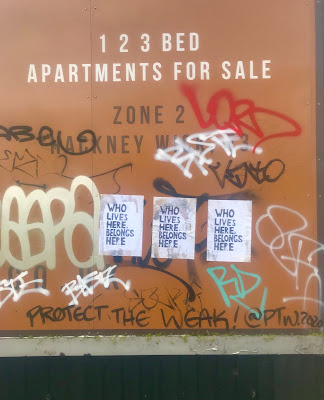From the radical canvas that is the streetscape of South East London, a few recent interventions in the social fabric...
Up against the wall
Seen on the bus stop outside Goldsmiths in New Cross today (20 February 2021):
The full text reads: ' We are all outlaws in the eyes of England / In order to survive we steal cheat lie forge f*ck hide and deal/ We are obscene lawless hideous dangerous dirty violent and young / But we should be together / Come on all you people standing around / Our life's too fine to let it die / We can be together/ All your private property is target for your enemy/ And your enemy is we /We are forces of chaos and anarchy / Everything they say we are we are /And we are very proud of ourselves /
Up against the wall / Up against the wall Motherf*cker'
These are in fact the lyrics to Jefferson Airplane's 1969 song 'We can be together', with just one change - substituting England for America in first line. The location is apposite.
As discussed here before, Fred Vermorel has stated that he introduced later Sex Pistols manager Malcolm McLaren to 'situationism at the 36 bus stop, just outside Goldsmiths College in Lewisham Way'. McLaren and Vermorel were at this time (late 60s) in the milieu around the radical group King Mob, influenced by the Situationists and the New York group 'Up Against the Wall Motherf*ckers'. Jefferson Airplane lifted some of the lyrics for their song from a text written by the latter.
All that is solid melts into air
Coulgate Street, Brockley, February 2021, a phrase from Marx and Engels written in 1848 in the Communist Manifesto:
The full quote: 'Constant revolutionizing of production, uninterrupted disturbance of all social conditions, everlasting uncertainty and agitation, distinguish the bourgeois epoch from all earlier ones. All fixed, fast-frozen relations, with their train of ancient and venerable prejudices and opinions, are swept away; all new-formed ones become antiquated before they can ossify. All that is solid melts into air, all that is holy is profaned, and man is at last compelled to face with sober senses his real conditions of life and his relations with his kind'. People sometimes miss the point of this quote - Marx and Engels thought it was a good thing that capitalism was progressively sweeping away older ways of life and thought. Were they right? Discuss.
Men make their own history, but they do not make it as they please
Another Marx quote featured on a poster nearby on Brockley Road last summer (2020)
This is from 'The18th Brumaire of Louis Bonaparte' (1852): 'Men make their own history, but they do not make it as they please; they do not make it under self-selected circumstances, but under circumstances existing already, given and transmitted from the past'. I prefer it with the next line 'The tradition of all dead generations weighs like a nightmare on the brains of the living'. Oh and I think Marx used the term 'Menschen' more correctly translated as gender neutral 'people' rather than 'men'.
Free the Uyghurs
The mass detention and repression of the Muslim Uyghur minority by the Chinese state should be provoking sustained global outrage and solidarity. A bit of a graffiti in Briant Street, New Cross feels inadequate but at least it's there.
Who Lives Here Belongs Here
Posters on an estate agents billboard in Trundleys Road, SE8. Note also Biblical injunction in graffiti 'protect the week', referencing Psalm 82 'Defend the weak and the fatherless; uphold the cause of the poor and the oppressed. Rescue the weak and the needy; deliver them from the hand of the wicked'.
Travis Alabanza Street
Erlanger Road SE4 renamed after trans activist, artist and writer. Seemingly the work of
























.jpg)












